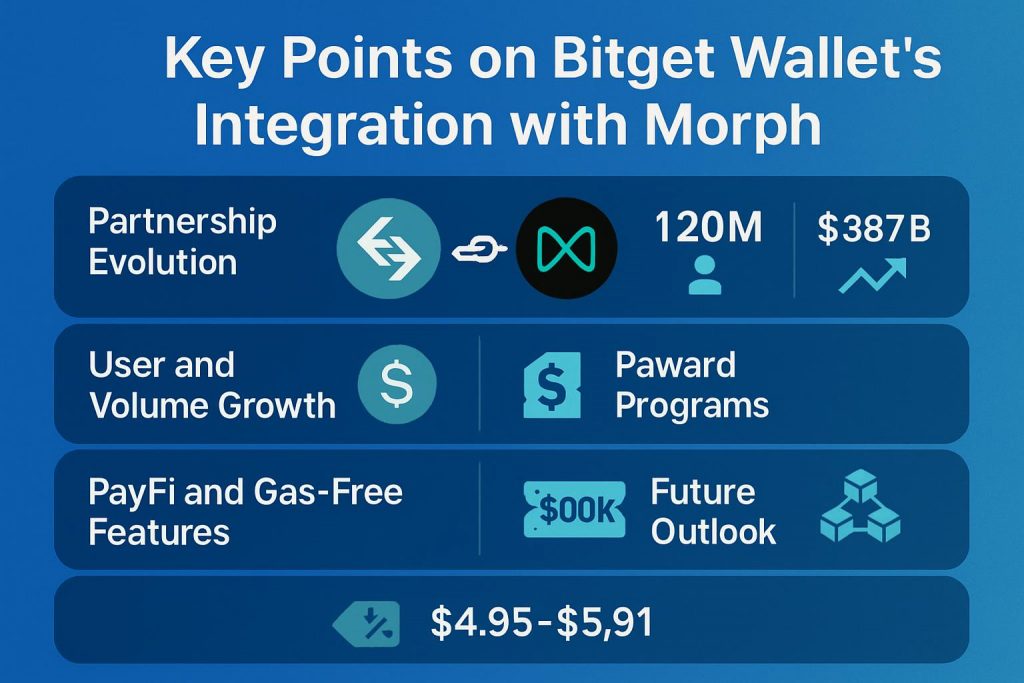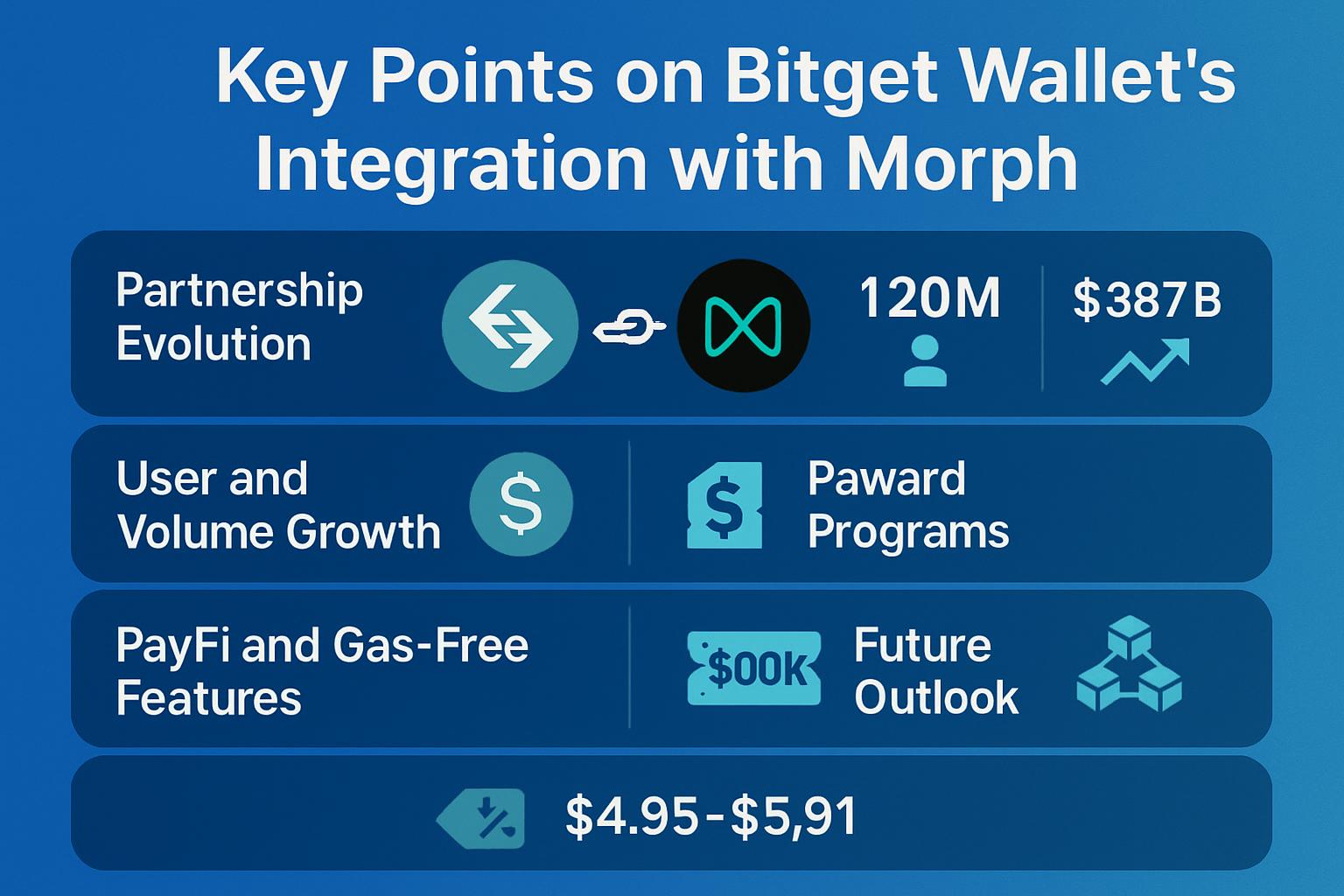PayFi Revolution: How Bitget Wallet & Morph Are Changing Crypto

In the fast-paced arena of cryptocurrency, where fortunes pivot on the next big layer or token burn, the Bitget Wallet-Morph integration stands out as a calculated play to democratize Web3 payments. Picture this: a wallet ecosystem boasting over 120 million users by mid-2025, churning through transaction volumes that topped $387 billion in spot trading alone during Q1, now fused with a Layer-2 blockchain designed explicitly for consumer finance. This isn’t just another tech hookup; it’s a strategic pivot toward PayFi—short for Payment Finance—a hybrid model blending seamless on-chain transactions with real-world utility, like gas-free payments and programmable rails that could finally lure mainstream money into the crypto fold.
Key Strategic Moves in the Bitget Wallet-Morph Integration
- Partnership Escalation: By September 2025, Bitget solidified its strategic partnership with Morph, executing a 440 million BGB token transfer to the Morph Foundation. This move established BGB as Morph’s native gas and governance token, a strategic play to enhance liquidity and adoption, though market volatility introduces inherent risk.
- Explosive Growth Metrics: Bitget Wallet’s ecosystem now commands over 120 million users by mid-2025, with Q1 2025 spot trading volumes exceeding $387 billion. This robust expansion underscores market traction but signals intensifying competitive pressures in the crypto wallet sector.
- PayFi Innovation: The integration prioritizes PayFi for seamless on-chain payments, with gasless transactions slated for Q4 2025 rollout. This initiative aims to bridge traditional finance and blockchain, positioning for mainstream adoption despite persistent regulatory hurdles.
- Incentivized Adoption: To ignite engagement, a $500,000 creator campaign and the Morph Unity Airdrop, distributing 270,000 BGB, are underway. Success hinges on community response amidst fluctuating market sentiment.
- 2026 Outlook: Analysts project BGB price stability within the $4.95–$5.91 range through 2025. Morph’s roadmap targets full zk-Rollup upgrades by 2026, signaling growth potential in consumer finance, contingent on Ethereum’s ecosystem health and global economic factors.
Let’s rewind to trace how we got here. Bitget Wallet’s roots trace back to its 2018 launch as BitKeep, a non-custodial multi-chain wallet that quickly gained traction for its user-friendly interface and broad blockchain support. By 2023, amid a rebranding to align with the Bitget exchange, it had already amassed millions of users, leveraging features like keyless MPC (Multi-Party Computation) wallets to lower entry barriers for novices. Milestones piled up: surpassing 40 million users by mid-2024, then exploding to 60 million by year-end with over 300% annual growth, fueled by integrations like Telegram mini-apps and gas vouchers that offset fees during campaigns. Transaction volumes mirrored this ascent, hitting $387 billion in Q1 2025 spot trading alone, while the broader ecosystem—including the exchange—pushed past $2 trillion in quarterly activity, underscoring Bitget’s rise as a top-tier player in a market dominated by Binance and Coinbase.
Morph, meanwhile, entered the scene in 2024 as an ambitious Ethereum Layer-2 solution, blending optimistic rollups for speed with zero-knowledge proofs for security—a hybrid approach promising sub-$0.01 fees and thousands of transactions per second (TPS). Backed by a $20 million seed round from heavyweights like Bitget Capital (which took a 20% stake), Morph launched its testnet in early 2024, followed by mainnet in October, focusing on consumer-grade dApps for payments, payroll, and daily finance. The initial Bitget Wallet integration that month made Morph a default mainnet option, offering users real-time token insights and a dedicated DApp zone, all while Bitget positioned itself as Morph’s launchpad for mainstream adoption.

Fast-forward to September 2025, and the partnership hit warp speed. Bitget transferred 440 million BGB tokens—its native utility token—to the Morph Foundation, instantly burning 220 million to induce scarcity and unlocking the rest for liquidity, growth initiatives, and education. This move enshrined BGB as Morph’s gas and governance token, powering on-chain payments and utilities across a network now serving as the settlement layer for Bitget’s 120 million+ customers globally. Community buzz on platforms like X highlighted the shift, with users noting seamless integrations like USDC-MORPH and USDT-MORPH pairs for deposits and real-time PnL tracking in Bitget Wallet.
Today, in October 2025, Morph hums with over 200 dApps, from DEXs to yield platforms, all benefiting from its EVM compatibility and decentralized sequencer plans. PayFi takes center stage, with features like on-chain FX modules for real-time stablecoin swaps and upcoming gasless transactions set for Q4 rollout, eliminating barriers for everyday users. Reward programs add fuel: the Morph Unity Airdrop, hosted exclusively by Bitget Wallet, distributes 270,000 BGB through October 25, while a $500,000 creator campaign rewards original content and on-chain activity, channeling funds back to communities. Yet, not all is rosy—regulatory eyes on stablecoins and crypto cards (like Bitget’s Mastercard partnership) could introduce headwinds, as seen in broader market dips.
Peering into the crystal ball, Morph’s roadmap through 2026 is a blueprint for ambition. Q3 2025 kicked off with the Morph Payment Card (Phase 1) and first-party yield products, targeting markets in Korea, SEA, and China. Q4 promises gasless transactions, cross-chain yields, and liquidity mining across exchanges. By 2026, expect Morph Rails—a permissionless payment platform—decentralized cards, staking mechanisms, and a full zk-Rollup upgrade for privacy and scalability, culminating in DAO governance. Analysts forecast BGB holding steady at $4.95–$5.91 through 2025, with upside to $10–$16 if PayFi gains traction, potentially tapping into a $10 trillion global payments pie. But risks loom: Ethereum congestion, competing L2s like Optimism or Arbitrum, and macroeconomic factors could cap growth.
To illustrate key metrics, here’s a comparison of Bitget Wallet’s growth trajectory:
| Metric | End of 2024 | Q1 2025 | Q2 2025 | Projected End of 2025 |
|---|---|---|---|---|
| User Base (Millions) | 60 | 120 (Ecosystem) | 120 | 150+ |
| Spot Trading Volume ($B) | N/A | 387 | ~500 (Estimated) | 1,500+ |
| Transaction Growth (%) | 300 (Annual) | 159 (QoQ) | 20 (QoQ) | 200+ (Annual) |
| Key Features Added | Morph Mainnet Integration | Gas Vouchers, Rewards Center | Super DEX Upgrades | Gasless PayFi, Morph Rails |
Sources for table: Derived from Bitget’s Q1 2025 Transparency Report and Q2 2025 Transparency Report, and ecosystem updates.
And Morph’s ecosystem expansion:
| Phase | Key Launches | Focus Areas |
|---|---|---|
| 2025 Q3 | Payment Card Phase 1, Pay V1 Super-App, Yield Products | Regional Activations (Korea, SEA, China) |
| 2025 Q4 | Gasless Transactions, Onchain FX, Cross-Chain Yields | Liquidity Mining, SDK Upgrades |
| 2026 Q1 | Morph Rails, Decentralized Card, Merchant Network | Developer Incentives |
| 2026 Q2-Q4 | Staking, DID Services, zk-Rollup Upgrade, DAO Governance | DeFi Infrastructure, Token Utilities |
This integration isn’t merely technical—it’s a bet on crypto’s maturation. As an experienced cryptocurrency expert with over a decade navigating booms from Bitcoin’s $1 milestone to Ethereum’s Merge, I see this as a pragmatic evolution. Bitget’s bold BGB infusion mirrors how exchanges like Binance leveraged BNB for ecosystem lock-in, but Morph’s PayFi angle adds a consumer twist that could finally crack mass adoption. Yet, I’m cautiously optimistic: while low fees and rewards entice, true success hinges on navigating regulations and delivering on zk upgrades. If executed well, this could propel BGB to $10+ by 2026; otherwise, it risks fading in L2 wars. Investors, watch adoption metrics closely—this is Wall Street meets Web3, and the returns could be transformative.
Overall, this strategic convergence of a massive user base with a dedicated payment L2 offers a compelling glimpse into the future of Web3 consumer finance. However, for businesses and e-commerce merchants, the path to crypto adoption doesn’t need to wait for these sprawling ecosystems to fully mature. This is where enterprise-grade solutions like Aurpay bridge the gap between future potential and present-day revenue. While Morph builds out its PayFi infrastructure, Aurpay delivers an immediately deployable, non-custodial framework for accepting global crypto payments. Instead of navigating the complexities of Layer-2 rollups, merchants can add a crypto payment button in minutes, send customized crypto invoices, or integrate with leading e-commerce platforms. By leveraging secure smart contract services and a robust USDT payment gateway, businesses can tap into the 580 million-strong crypto user base right now, transforming speculative excitement into tangible, low-cost cross-border transactions.

